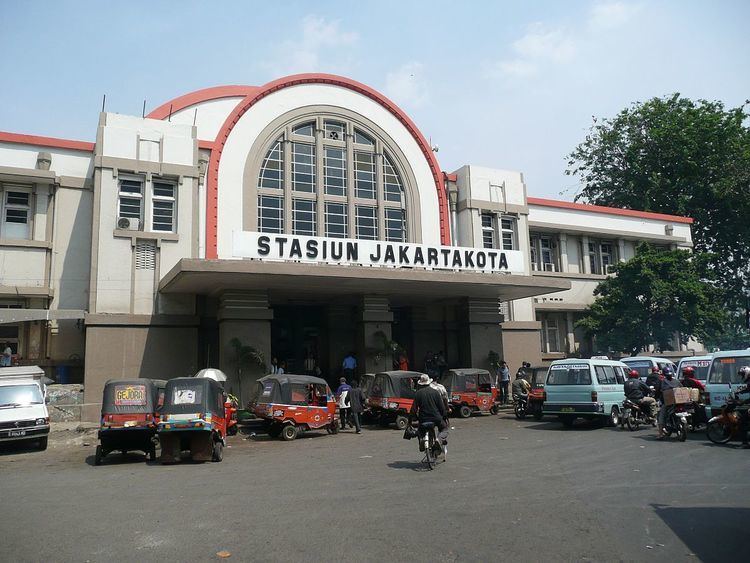Elevation +4 m Province Jakarta Platforms in use 6 | Opened 1870 Tracks 12 | |
 | ||
Location Jalan Stasiun Kota No. 1Pinangsia, Taman SariWest Jakarta 11110Indonesia Operated by PT Kereta Api IndonesiaKA Commuter Jabodetabek Line(s) Red Line Blue Line Pink Line Connections TransJakarta Corridor 1 TransJakarta Corridor 12 Address Jakan Lada, Pinangsia, Tamansari, Kota Jakarta Barat, 11110, Indonesia Similar Manggarai railway station, Gambir railway station, Jatinegara railway station, Kampung Bandan railway st, Pasar Senen railway st | ||
Jakarta kota railway station 2011 disco remix
Jakarta Kota Station (Indonesian: stasiun Jakarta Kota, station code: JAKK) is a terminal train station, located in the old city core of Kota, Jakarta, Java, Indonesia.
Contents
- Jakarta kota railway station 2011 disco remix
- Indonesian railways jreast 205 at jakarta kota
- History
- Building
- Services
- Intercity
- KRL Jabodetabek Commuter Line
- References
The station was named Batavia Zuid (or South Batavia) until the beginning of the 20th century. The station was also popularly known as the Beos Station as an abbreviation of Bataviasche Ooster Spoorweg Maatschapij (the Batavian Eastern Railway Company).
Jakarta Kota Station serves as a main station, along with Gambir Station, Jatinegara Station, and Pasar Senen Station, for several intercity train (Argo Train) lines across Java Island. This station also serves three of the six KRL Jabotabek train lines, which operate in the Jakarta metropolitan area.
Indonesian railways jreast 205 at jakarta kota
History
The first station was built in 1887 by the Bataviasche Oosterspoorweg Maatschapij (BOS), a private railway company. The station was named Batavia Zuid (South Batavia) to distinguish it from the older Batavia Noord (North Batavia) station (owned by the Nederlandsch-Indische Spoorweg Maatschappij, another private railway company), which was situated a small distance to the north, directly behind the former city hall. The public railway company Staatsspoorwegen acquired both the southern and northern station in 1898 and 1913 respectively.
The southern BOS station was closed in 1923, and was rebuilt between 1926 and 1929, during which all rail services were temporarily taken over by the Batavia North station. The station building was designed in 1927-1928 by the architects Asselbergs, Ghijsels and Hes from the architectural company Algemeen Ingenieurs-en Architectenbureau (AIA) in Batavia. During construction in 1928-1929 concrete from the Hollandsche Beton Maatschappij ("Dutch Concrete Company") was used. The main building was the designed with 12 railway tracks, designated to connect Batavia with Buitenzorg, the port of Tandjoeng Priok, and the port of Merak near the Sunda Strait with a ferry connecting Western Java with Southern Sumatra. The new and current building was officially opened on 8 October 1929 with a private ceremony by the company staff. All rail services to the old city were then reassigned to the new southern station, while the remaining northern station was demolished.
The new station was nicknamed BEOS after the previous station owners, the BOS. Officially named station Batavia Stad ("Batavia City station"), it is located at the Stationsplein ("Station square") in Batavia Benedenstad ("Downtown Batavia"), nowadays Jalan Stasiun Kota Barat. The station was appointed a historical and cultural landmark status in 1993.
Building
The design of the station by the Dutch architect Frans Johan Louwrens Ghijsels (born 8 September 1882) is a combination of Western Art Deco and local architecture styles.
Jakarta Kota Station is a two-storey station surrounded by streets on three sides with one main entrance and two side entrances. The main entrance and hall are characterized by a barrel vault roof with openings horizontally composed with the top dominated by vertical units (lunettes).
The inside wall of the hall is finished with rough-textured brown ceramic and the outside wall at the bottom of the whole building was covered with green-yellowish plaster. The station floor uses yellow teak and grey wood, and for the platform floor yellow waffle teakwood is used. Jakarta Kota station has six platforms serving 12 tracks. The platforms are sheltered by canopies supported by steel columns.
Services
Both regional intercity trains and local commuter trains start from this station: Nowadays most intercity trains (Except Local Trains) are moved to Pasar Senen and Gambir due to the busy KRL schedule that terminates here
